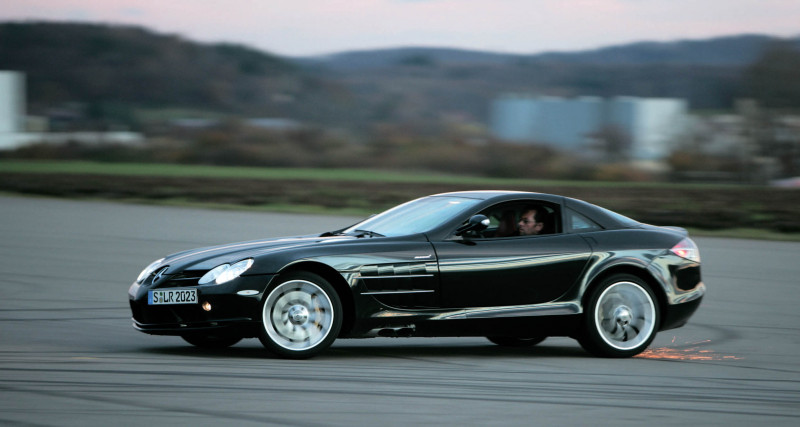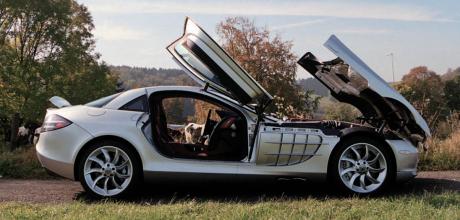2004 Mercedes-Benz SLR McLaren C199
Just over 1,400 of the Mercedes-Benz SLR McLaren were made between 2004 and 2009. Despite receiving a mixed reception when new, veteran helmsman Piotr R Frankowski explains why we should give more credit to this 200mph sports star.
Underrated
When the Mercedes SLR McLaren debuted in 2003 and journalists were able to sample it, very few immediately understood the nature of the car. Those who did not slandered it mercilessly, creating a myth which still influences discourse in the public sphere. The introduction of upgrades by McLaren MSO last year rekindled interest in the SLR, and rightly so. Here are some of my adventures with these cars when they were new…

The SLR was launched at a time when we, car journalists in Eastern Europe, still saw supercars mostly on their stands at the Geneva motor show. At that time, I enjoyed a very good relationship with some people over at Mercedes-Benz HQ and when I asked them to let me drive the new monster, they agreed. I was invited to Stuttgart and I had a plan.
As a fan of engineer extraordinaire Rudolf Uhlenhaut, I knew of the anecdotal tale of his speeding from Munich to Stuttgart for a meeting with executive Fritz Nallinger, and making the trip, over 125 miles long, in less than an hour in his ‘Uhlenhaut Coupe’ – the 300SLR with the then Formula 1 drivetrain and chassis. I wanted to try and beat, or at least equal, his time.
Thoughtful Mercedes friends got me a hotel where the underground parking lot permitted the opening of the doors: they had learned the hard way when a German journalist forgot how they opened and drove his door mercilessly into a low ceiling. I woke at 4am in the hope of catching the lightest possible traffic density on the autobahn.
Alas, the task proved impossible: speed cameras in many locations, too much traffic, too many drivers unable to see a silver missile approaching at 200mph. Suicide was not a part of my plan, so I had to give up. Instead, I prowled the streets of Stuttgart at night, practised long exposure night photography and answered hundreds of questions about the car in my grammatically incorrect German.
On the highway, the SLR was simply incredible: steady as a rock at speeds approaching 200mph, with the airbrake deploying and stabilising the rear under hard braking from such warp speeds (very much like the airbrake that Uhlenhaut put on the W196 back in the day). At low speeds, on completely dry tarmac, it was a beast, growling its way to brutal wheelspin even with the ESP engaged. Those comparing it to contemporary V12 Ferraris completely missed the point. They hated the low range torque (“Aus der drehzalkeller” – coming from the basement, as Germans would say), as well as the five-speed slushbox (the same as in the S-Class and Maybach, with a capacity for over 737lb ft of twist), and they despised its lairy behaviour in the wet.
But why? They were comparing apples to… no, not even to oranges, but to electric kettles. The supercharged Mercedes engine developed mountains of torque at all kinds of revs, even at idle. The Ferrari lump didn’t – it needed to be revved hard. Hence the need for the Ferrari to change gears quickly, to keep the engine in a fairly narrow powerband. The SLR powerhouse needed no rapid gear changes, because where a Ferrari would need to downshift to preserve momentum, the SLR gearbox could simply remain in a high gear, leaving it to the driver’s talent to carry speed through a corner whilst balancing the car with the throttle, with ample torque available without any need to execute a gearchange.
What the critics failed to see was that the SLR was not trying to be a Ferrari: it was a completely logical resurrection of such iconic Mercedes sports cars as the SS and the SSK. It did not need to shift gears for show. Torque versus revs, real speed versus an illusion of speed, skill versus showmanship. Not that the SLR was a shrinking violet, as its thunderous bellow from the side exhausts served as an additional safety measure and, again, reminded me of a similar aural sensation created by an SSK.
And yes, the hydraulic torque converter gearbox meant you could drive an SLR in heavy city traffic with no annoying jerkiness and no fear that the next clutch replacement bill would bankrupt you. And it didn’t break. The manual shift option was very well resolved, the software permitting the driver to consciously stay in a ratio no matter what the revs: it would only shift automatically in Manual mode when it was absolutely certain the engine would stall. So, yes, it would ultimately defer to the driver.
At that time, engineers still assumed someone buying a 617bhp car was aware of the skills necessary to drive it and not perish. It rolled in corners to communicate the lateral load, it had suspension travel to cover bumpy roads safely and to keep the wheels on the road. As the body had such immense torsional stiffness, the suspension could be made supple. Some people complained that the handling was far from ideal, with the car squirming and moving about on its suspension in certain situations. Yes, it did that – when the driver was hamfisted.
And only then. It was, and remains, the wrong type of car for internet heroes to own. Even when the ESP is in its default ‘on’ position, the SLR will not correct all of the driver’s mistakes.
The SLR could be very intimidating, too, just as a proper supercar should be. The auditory sensations connected with jaw-dropping acceleration zapped through one’s nervous system, meaning many short-term drivers could never relax. But I covered several thousand miles in these cars and can say with authority that on long trips they could be as relaxing as an S-Class. This is where they also differed from supercars from other makers, better suited for brief jaunts to fashionable districts in town centres. The SLR was a real 24/7 car, and thus had to be a compromise.
I normally abhor open-top cars, as I enjoy neither the exhibitionism nor the tangled hair. However, I was ready to make an exception for the SLR Roadster, because at its launch I heard from the then technical director of SLR and Maybach, Dr Jürgen Weissinger, that due to the high cockpit sides the car was usable with the top down at speeds well over 186mph and that the top itself was a far cry from the miserable efforts of other supercar manufacturers of the era. The leading edge was actually a billet chunk of solid aluminium with a special technical fabric attached to it with adhesive. Therefore it did not flap about and did not deform at very high speeds.
This was a rare achievement: a roofless supercar which could actually be used with its top up or down in its whole speed range (unlike the contemporary Lamborghini Murciélago Roadster, for example). And yes, I tested the alleged lack of buffeting on the narrow but derestricted autobahn between Giessen and the Frankfurter Kreuz junction. Up to an indicated 320km/h (199mph), it was really impressive; my passenger will probably remember the lack of buffeting less vividly than my application of a visible amount of opposite lock at about 270km/h (168mph) when we hit a small compression in a curve under an overpass…
All that is good, but there was a variant of the SLR McLaren which was better. My favourite – the 722. With a slightly more powerful engine (641 instead of 617 ponies) and a number of subtle but very effective aero and chassis tweaks, it retained a lot of public road poise, but was a much sharper tool on demanding stretches of tarmac.
I distinctly remember my Polish colleague trying to kill me on the launch when he failed to see a herd of camels standing in the middle of the road on which we were traveling at over 120mph. I had to deny him the pleasure of driving the car from that moment onwards, as he confessed he had not been wearing his prescription glasses “because he didn’t look good enough in them”.
The second incident happened when I was doing tracking shots with Dieter Rebmann who was hanging out of the back of an ML. Other journalists, with whom I had become friendly over the preceding days, told their PR person that I was the slowest, safest driver of the whole group and they decided to ride shotgun. When the shots were done and Dieter raised his thumb, I turned the car around and used all of the 722’s accelerative capacity. In the middle of a long, uphill corner (yes, there are areas in Dubai which have corners!), I pointed at the speedo and asked my passenger whether they had ever seen 270km/h in the middle of a corner before. When we returned to the camp, they actually ran away…
My memories of driving a number of various SLR variants in diverse weather and road conditions are invariably positive. I must confess to shuddering upon reading magazine articles on the new McLaren MSO mods in which the young authors freely admit to never having driven a standard vehicle, but criticise it anyway due to something called “internet wisdom”. Well, they are all wrong.
Just the facts 2004 Mercedes-Benz SLR McLaren (C199)
- ENGINE M155 5,439 V8 supercharged
- Max POWER 617bhp @ 6,500rpm
- Max TORQUE 575lb ft @ 3,250-5,000rpm
- TRANSMISSION 5-speed auto, RWD
- WEIGHT 1,768kg
- 0-62MPH 3.8sec
- TOP SPEED 208mph
- FUEL CONSUMPTION 19.5mpg
- YEARS PRODUCED 2004-2008
All figures from Mercedes-Benz; fuel consumption according to NEDC Combined
Road testing the 722 Edition in the Middle East. ff 722 with more aero and a stiffer ride. The 2004-on SLR still looks sensational.
The 722 was a much sharper tool on demanding stretches of tarmac
Ownership
The SLR was never massively popular in the UK when new, mainly because of a lot of negative press reviews (often written by people who had never driven one) and because it was only ever available in LHD. At the time of writing, several vendors in Great Britain were offering standard Coupe and Roadster versions in the price range of £250,000 to £290,000.
Given the performance and the old school, analogue feel of the car, prices seem reasonable. Picking the right car is not so easy, however. Many SLRs have spent years and even decades tucked away in garages with no driving and no real maintenance. Seals, gaskets and bushes deteriorate with time, more rapidly in cars which never go through heat cycles and where fluids don’t circulate on a regular basis.
Cars which have had correct and timely maintenance (costly and time consuming) are actually in the very same price range as neglected cars with a lot of shiny wax on the body and very old tyres on their rims. Spend some time looking and you can catch a really good one which won’t kill you because of what Germans call “wartungsstau”, or basically a backlog of required maintenance.
The Roadster SLR debuted at Goodwood in ’07. Carbon fibre composite body is incredibly rigid. Supercharged 5.4L V8 linked to five-speed auto. Aluminium, carbon and leather grace the two-seat cabin. Starter button on top of the gearlever. C199 with its spiritual forbear, the 300SLR Coupe.
It was, and remains, the wrong type of car for internet heroes to own
On the highway, the SLR was simply incredible


